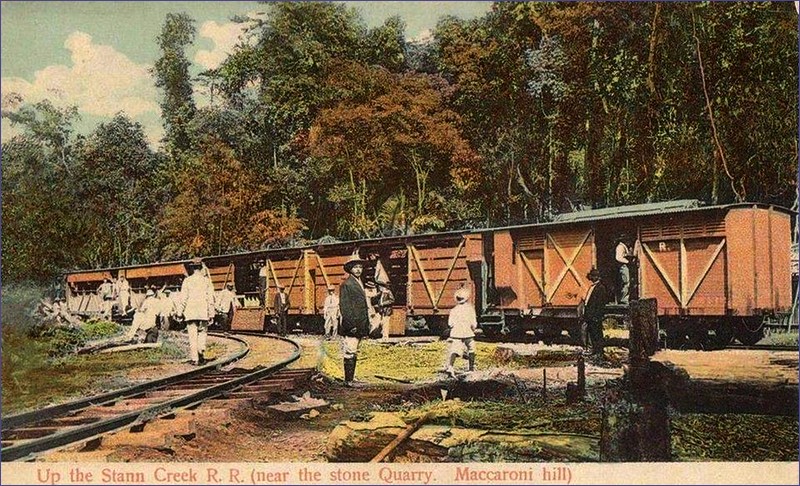There are no railways in Belize and there are no plans to rebuild dismantled railways or to build a new ones. There were railway lines and trains in Belize in the past – mainly narrow gauge railways used for logging industry. These lines were built along the rivers and were intended to transport timber, sugar and bananas. All lines were closed by the late 1950s. There have been no railway connections to other countries.
There are currently no active railways in Belize, and there are no plans to build new railways. In colonial times, there were three longer narrow-gauge railways and several shorter ones built along the rivers – all of them were used to transport bananas, timber and sugar, although passenger cars could be found in the Stann Creek Railway depots.
Trains in Belize – Stann Creek Railway
The Stann Creek Railway is the most important railway line in Belize’s history – the only line with regular passenger service.
In 1892, the British Honduras Syndicate built a short horse-drawn tram line connecting the company’s headquarters in the town of Melinda with the pier at Stann Creek Town (today the town of Dangriga).
Mule-drawn carriages were unusual at that time, and the colonial authorities, impressed by the usefulness of the horse-drawn tram, began preparations for the construction of a railway.
Construction of the line began in 1907. A year later, the first section was opened, and later two more sections were officially inaugurated:
Commerce Bright – Hope Creek (14 km)(17 October 1908)
Hope Creek – Macaroni Hill (17 March 1909)
Macaroni Hill – Valley Community (4 October 1910)
October 17, 1908 – opening of the section (approx. 14 km)
The railway was extended and in 1911, including branches to farms and plantations, the length of the network classified as the Stan Creek Railway was approximately 40 kilometers.
The railway was built by Jamaican immigrants, whose descendants still living in the Stann Creek Valley. The rail gauge was 914 mm.
From 1913, the railway was managed by The United Fruit Company under an agreement with the colonial authorities. Trains transported bananas from nearby plantations, which were then loaded onto ships bound for the United States.
Beginning in 1924, banana production in the Stann Creek Valley became less and less profitable, and the number of trains was gradually reduced. A year later, the authorities signed an agreement with the Tidewater Lumber Company to transport timber from forests to ships bound for the United States.
In 1927, only two trains ran per week – the plantations were leased to immigrants from Jamaica. The train leaving on Monday delivered new workers as well as groceries and tools to the plantations, the train leaving on Thursday collected crops, which were then delivered to the port, where steamships were waiting. Trains were operated by United Fruit Company.
In the early 1930s, trucks appeared on the roads and the narrow-gauge railway can’t withstand the competition with road transport. Timber and banana production gradually disappeared in the Stann Creek valley.
In 1938, the last train ran on the Stann Creek Railway.
A few traces of the railway remain today, mainly visible along the Hummingbird Railway. These are mainly the remains of railway bridges. Many of the other remains were thoughtlessly destroyed during the renovation and expansion of the highway in the 1990s.
Railways in Belize – Vaca Falls Railway
A narrow gauge railway built in the mid-1920s by the Mengel Company of Kentucky to transport lumber. An one section (Vaca Falls – Chiqubul Forest) was so steep that it could be considered one of the steepest railways in the world.
The Vaca Falls Railway was approximately 23 kilometers long and ran through what is now the Mountain Pine Ridge Nature Reserve. In the post-war years it was managed by the Belize Estate and Produce Company and operated until 1952.
Only the skeleton of a locomotive has survived on the line near Arenal.
Railways in Belize – The Gallon Jug Hillbank Railway
A narrow-gauge railway intended for timber transport was built by lumberjacks from Great Britain, associated with the Gliksten Group. Construction began in 1890, and in the best years the length of the railway line from Gallon Jug to Hill Bank was approximately 40 kilometers.
In the 1940s, trucks began to be used on a large scale to transport timber in the area. The railway gradually fell into decline until it was closed in 1956.
According to some sources, in last years of operation there have been small railbuses on the line to transport passengers.
Gallon Jug station was located about 10 kilometers from the border with Guatemala, but a railway connection between the countries was never built.
Some of the narrow gauge railway equipment was sold for scrap, some was exported to the United States, and the rest was absorbed into the jungle.
Railways in Belize – Serpon Sugar Mill Train
On the site of the former Serpon sugar factory, there are, among others, the remains of a sugar cane railway used to transport sugar cane along the Sittee River. The sugar factory operated in the years 1865-1910, today near the village of Sittee River. The preserved elements of the old sugar factory are a tourist attraction and archaeological site.
The sugar factory was founded by immigrants from the United States who fled to Belize before the Civil War. At that time it was an engineering marvel. Huge steam engines covered with rust and patina remind us of the times of glory.
There is no further information about the sugar cane railway.
Related articles:
Railways in Americas by country
